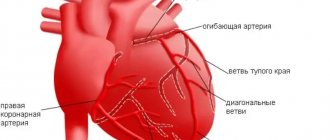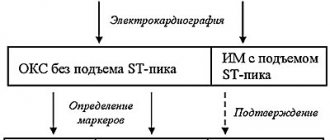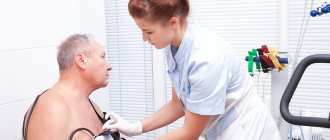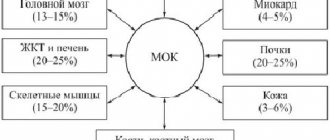Hypertension is a pathology of the heart and blood vessels, manifested by increased blood pressure. In the pathogenetic mechanism of the formation of the disease, disturbances in the neurohumoral, central and renal mechanisms of blood pressure regulation play a huge role.
Arterial hypertension is one of the fundamental risk factors for the development of potentially fatal diseases - stroke and heart attack. That is why it is important to know why hypertension occurs, how it is diagnosed and what medications are used in treatment.
Development of hypertension
The essence of the disease is frequent and/or persistent increase in blood pressure.
The origin of the disease is still unknown, but there is disruption of the heart and increased vascular tone. Depending on the level of high blood pressure, there are three degrees of severity of hypertension: 1 degree (mild, soft) - the patient’s pressure is in the range from 140/90 to 159/99; 2nd degree (moderate) - pressure ranges from 160/100 to 179/109; Grade 3 (severe) - blood pressure above 180/110.
General information about the disease
The occurrence of complications due to high blood pressure is associated with damage to vital “target organs”: myocardium, brain, kidneys. The heart is the first to be involved in the pathological process. Already in the early stages of hypertensive disease, changes in the size of the organ, the shape of the cavities, and the thickness of the walls of the left ventricle are noted. Against the background of dystrophic transformations, the following is observed:
- the appearance of arrhythmia;
- development of ischemic disease;
- increase in heart failure;
- disturbance of atrioventricular conduction.
This form of hypertension is known to the general public as “hypertensive heart.”
A systematic increase in blood pressure threatens serious damage to the heart muscle, the development of such severe cardiovascular disorders as myocardial infarction, acute heart or kidney failure, and cerebral stroke.
Risk factors
A number of factors contribute to the development of hypertensive myocardial disease:
- geodynamic – cardiac output, vascular patency, elastic resistance, viscosity and volume of circulating blood;
- extracardiac – patient’s gender, age, excess weight, cholesterol level, diabetes mellitus, bad habits.
Dystrophic changes in the heart muscle are more common in young men suffering from arterial hypertension than in women. With age, the trend changes: the prevalence of pathology in females increases during menopause.
Obesity is a powerful factor that provokes cardiac hypertrophy. As body weight increases, the weight of the organ and the thickness of its walls also increase. Hereditary factors play a certain role.
Stages of hypertensive heart disease
Hypertension with primary damage to the heart goes through certain stages of development:
- The first stage is functional disorders: the oxygen demand of the heart muscle increases, the function of the left ventricle is impaired, the emptying index of the left atrium decreases, there are still no visible subjective symptoms.
- The second stage - the process of remodeling the myocardial structure begins, the left atrium enlarges.
- The third stage - the development of dystrophic changes continues, against the background of increased peripheral vascular resistance, left ventricular hypertrophy develops, when diagnosed, hypertensive heart disease without heart failure is determined.
- The fourth stage - heart failure develops as a consequence of the progression of hypertrophy and circulatory disorders.
As changes in the left ventricle increase, an imbalance arises between the high demand of the heart muscle for oxygen and the limited volumes of its supply through the coronary vessels.
As a result, hypertrophy goes from a physiological form to a pathological one.
The pathological process of heart damage in arterial hypertension goes through three stages of progression:
- initial – the occurrence of hypertension, the appearance of myocardial dysfunction;
- latent (compensatory) – stable balancing of impaired functions;
- impaired compensation – development of complications: heart attack, stroke, heart failure, death.
During this period, pronounced structural and vascular changes are observed:
- left atrium enlargement;
- thickening of the walls, expansion of the cavity of the left ventricle;
- growth of fibrous tissue;
- increasing collagen levels;
- accumulation of water in the walls;
- proliferation of vascular walls;
- impaired vascular response to the influence of vasoactive factors.
Pathological processes are accompanied by disruption of metabolic processes and microcirculation in the myocardium, as well as its contractile activity.
Symptoms of hypertension
In the absence of treatment and secondary prevention, the disease progresses. Depending on the damage to target organs, they are distinguished: Stage I. Typically, but not necessarily, characterized by a mild and intermittent increase in blood pressure without target organ damage. However, it is quite possible for both a crisis and a completely asymptomatic course of the disease. In addition to high blood pressure, the patient may be concerned about:
- headache;
- decreased performance;
- tendency to fluid retention;
- fast fatiguability.
Stage II is characterized by the appearance of signs of damage to target organs (heart, kidneys and brain, as well as blood vessels, including the eyes, which may be accompanied by the appearance of new symptoms and complaints, as well as according to additional laboratory and instrumental studies:
- pain in the “heart area”;
- dizziness;
- visual impairment;
- the appearance of edema;
- memory loss;
- shortness of breath on exertion.
Stage III - complicated hypertension. The main sign of the course of the disease at this stage is severe damage to target organs with thrombosis, including heart attacks and strokes, accompanied by the following symptoms:
- hand tremors;
- noise in the head or ears;
- significant memory loss;
- nausea, vomiting;
- persistent visual impairment;
- various heart disorders.
Most of these symptoms are stable and usually progress, reducing performance.
Symptoms of hypertension
The severity of clinical symptoms depends on the level of pressure increase and the involvement of the so-called target organs in the process. This term refers to those organs on which a prolonged increase in pressure affects the most unfavorably: the retina of the eyes, the brain, the kidneys, the heart.
At the initial stage, patients are usually bothered by dizziness and periodic headaches. An increase in pressure is usually accompanied by tinnitus, nausea, palpitations, and pulsation in the head.
The progression of the disease leads to symptoms of heart failure: shortness of breath during exercise, a feeling of lack of air. The chronic nature of the pathology is accompanied by swelling of the legs and puffiness of the face.
When blood pressure jumps, visual impairment may occur in the form of “floaters” in front of the eyes and decreased visual acuity. The most important symptom is an increase in pressure, confirmed instrumentally!
Diagnosis of hypertension
Diagnosis of hypertension is performed by a cardiologist. To identify the disease and individualize treatment, the following methods are used:
- dynamic blood pressure measurement;
- laboratory tests - clinical and biochemical blood tests, general urine analysis;
- electrocardiography, including in the form of Holter monitoring;
- ultrasound examinations: heart, kidneys and other organs;
- Dopplerography (ultrasound of blood vessels).
Subjective symptoms of the disease
About 65% of patients suffering from cardiac hypertension report the following symptoms:
- shortness of breath, increased heart rate;
- headache, dizziness;
- hyperemia (redness) of the facial skin;
- moderate pressing pain in the chest;
- fluctuations in blood pressure;
- increased anxiety, feeling of fear.
The rest of the patients do not find any manifestations other than periodic or episodic increases in blood pressure. They lead their usual lifestyle until they encounter one of the possible complications of the pathology.
Treatment of hypertension
To treat the disease, both drug and non-drug therapy are used. Hypertension medications are aimed at preventing high blood pressure. The doctor also recommends lifestyle changes, such as a special diet or moderate exercise. In our clinics on Gorokhovaya St., 14/26
(metro station Admiralteyskaya, Admiralteysky district) and on
Varshavskaya st., 59
(metro station Moskovskaya, Moskovsky district) there are
therapists
and
cardiologists
who will diagnose and draw up a suitable treatment plan for hypertension.
You can make an appointment by calling 493-03-03 or on our website. Make an appointment
Predisposing factors
- excessive consumption of salt (more precisely, sodium, which is part of salt),
- atherosclerosis (these two diseases seem to reinforce each other and often go together),
- smoking,
- excessive drinking,
- increased body weight - obesity
- physical inactivity (that is, a sedentary lifestyle).
Treatment of hypertension involves the correction of all risk factors a person has. Sometimes this alone is enough to significantly reduce blood pressure.
treatment of hypertension When measuring blood pressure, doctors examine two parameters - the upper (systolic pressure) and the lower (diastolic). With some degree of convention, we can say that the main contribution to the first is the strength of heart contractions, and the second is supported by vascular tone. Therefore, when prescribing treatment, doctors are guided by which pressure - systolic or diastolic - is more elevated. In the first case, you need to “slow down” the heart a little, and in the second, you need to dilate the blood vessels.
Hypertension is dangerous because severe or constant vasospasm causes insufficient blood flow to vital organs - the heart, brain and kidneys. If there is excessive spasm of the arteries or if there are atherosclerotic plaques in the vessels, blood may completely stop flowing through the artery, and then a sharp circulatory disorder may occur. This is how stroke and myocardial infarction develop.
Hypertensive crisis
With a sudden sharp increase in blood pressure, tinnitus may be accompanied by nausea, vomiting, headache, flashing spots or darkening in the eyes, as well as narrowing of the visual field. Overall, a very painful condition. At this moment, people’s mood changes: irritability, tearfulness, etc. appear. In such a situation, measuring blood pressure can show very high numbers (we do not give specific parameters, because for each person “very high blood pressure” is characterized by different indicators). This condition, called by doctors “hypertensive crisis,” is dangerous due to the development of complications from the heart and blood vessels of the brain.
Symptoms
Headache is perhaps the most common manifestation of high blood pressure, or, as it is called, hypertension. It is associated with spasm of cerebral vessels. Sometimes other symptoms are observed: noise in the ears (such as a hum or ringing), flickering of “spots” or “sparkles” in the eyes, blurred vision. This is also due to impaired blood circulation in the areas of the brain responsible for sound and color perception, and in addition, the blood supply to the actual sound-receiving devices of the ear and the light-receiving structures of the eye is also disrupted. Shortness of breath may occur, as well as chest pain (this pain is associated with impaired blood supply to the heart muscle - the myocardium - due to the same vascular spasm).
Advantages of diagnosing and treating hypertension at the Miracle Doctor clinic:
- Doctors. The therapists at our clinic have extensive experience in treating various forms of hypertension. Doctors of other specialties actively help them in this: cardiologists, neurologists, ophthalmologists.
- Instrumental diagnostics. Hypertension may be episodic and therefore go undetected with routine blood pressure measurements. For more detailed diagnostics, our clinic conducts 24-hour blood pressure monitoring using a special portable device fixed on the patient’s body. In this case, the patient can stay at home and do his usual work.
- Laboratory equipment. Hypertension often occurs against the background of changes in hormonal levels, blood glucose levels and urine properties. The laboratories of our clinic, equipped with modern equipment, determine all the necessary indicators in blood and urine tests.








